 2025 Honda Livo 110 Launched: New Features, New Features, & More
2025 Honda Livo 110 Launched: New Features, New Features, & More
 Auto Expo 2025: Top 10 Highlights From Bharat Mobility Global Expo 2025
Auto Expo 2025: Top 10 Highlights From Bharat Mobility Global Expo 2025


“Throughout our long and successful twin-cylinder history of racing, Ducati has never built a sportbike as advanced as the 1199 Panigale," – Claudio Domenicali, General Manager, Ducati. And that dear friends, is the ultimate truth in every sense of the word. Having followed the Italian brand ever since I can remember, Ducati has never gone ahead and done something so radical that has challenged its well-established fundamentals like the trellis frame or belt-driven cams. Their trademark V-twin engines have been serving the range of several Ducati-badged motorcycles since the introduction of the Ducati Pantah in 1979. However, since then three whole decades have passed by and a lot has changed in the global motorcycle industry. But more importantly, the 1199 Panigale hints at the bigger changes that have taken place within the Bolognese factory of Ducati.
For the 1199 Panigale, Domenicalli had clearly earmarked two objectives – 195bhp and 10kg weight reduction over Ducati’s previous flagship, the 1198. Now these were tall benchmarks set for the traditional Ducati V-twin technology on which the research and development work had reached its zenith. Clearly from the very beginning the boffins at Ducati knew they had their work cut out to start over a blank sheet of canvas and get creative with design, technology, materials, etc. – basically about anything and everything that went into building a racing motorcycle for the road. The project which began as far back as end of 2006 finally materialized after four long years of hard work and endless development on an all-new Ducati road-bike – the 1199 Panigale, unveiled to the world at the 2011 EICMA Motorcycle Show held in Milan every year.
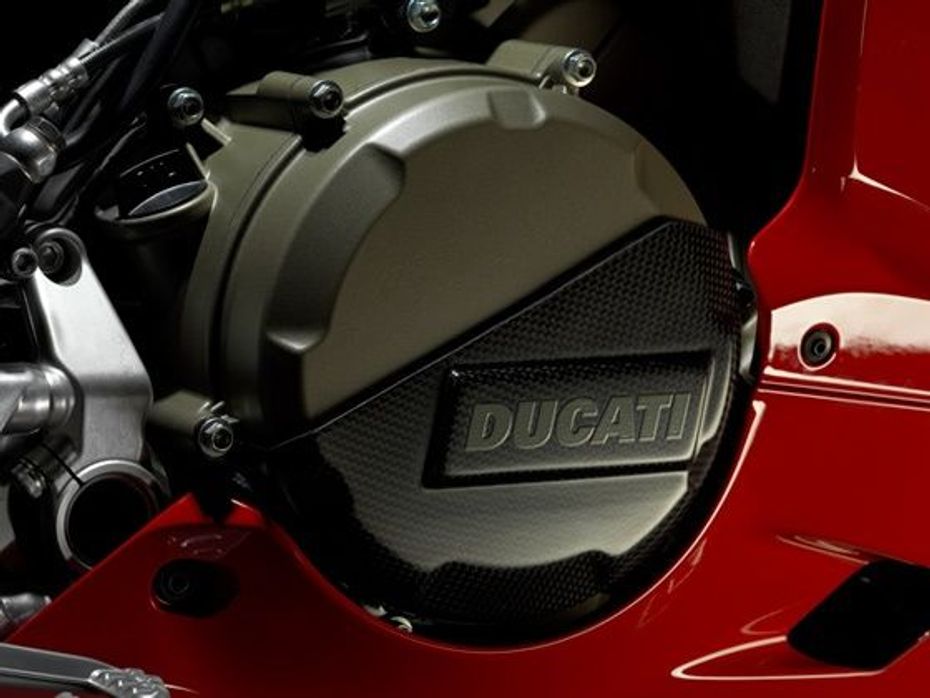
Building an all-new motorcycle from ground-up meant the allocation of resources, gathering the right personnel and having a clear objective for smooth functioning of the task at hand. In order to achieve the targeted weight saving on the new bike, the firm had to ditch its trademark steel trellis tubing and opt for something lighter. Rightfully chosen was an all-new (first time on a Ducati) aluminium monocoque chassis which helped the company with significant weight savings of about 5kg. This was achieved via linking the steering head and the engine with an all-new die-cast aluminium airbox that equally shares the stress with the 1199cc SuperQuadro V-twin powerplant, which also acts as a stressed member. A lesson repeated from the history books, the lightweight airbox is sealed with the help of the fuel tank sitting atop, similar to the iconic Ducati 916. With the motor also acting as an integral part of the chassis, it was critical that the newly designed motor had load-bearing engine casings for which the crankcases have been made out of vaccum die-cast using Vacural technology in order to increase their strength as well as for weight savings.
In terms of design too, the focus was on weight saving measures to make the 1199 Panigale an ultra-compact machine, a cause hugely helped by the rather lightweight and compact dimensions of a V-twin powerplant. Like its designer Gianandrea Fabbro puts it, “The Panigale design came from necessity.” The idea for an under-seat exhaust was dropped and an under- belly unit was employed for better mass centralization as well as eradicating the need for a heavier and sturdier rear subframe thus handing weight saving benefits. The gorgeously crafted die-cast lightweight swingarm is 39mm longer than the 1198 taking the wheelbase of the 1199 Panigale to 1437mm in order to improve traction from the massive 200-section Pirelli Diablo Supercorsa rear tyre, based on the inputs gathered from the firm’s racing division, Ducati Corse. The widest ever to go onto a road-going production superbike, during the initial testing on the Mugello circuit, the 1199 Panigale in the hands of Ducati test rider cut almost a second per lap with the massive 200-section as against the previously considered 190-section rear tyre.
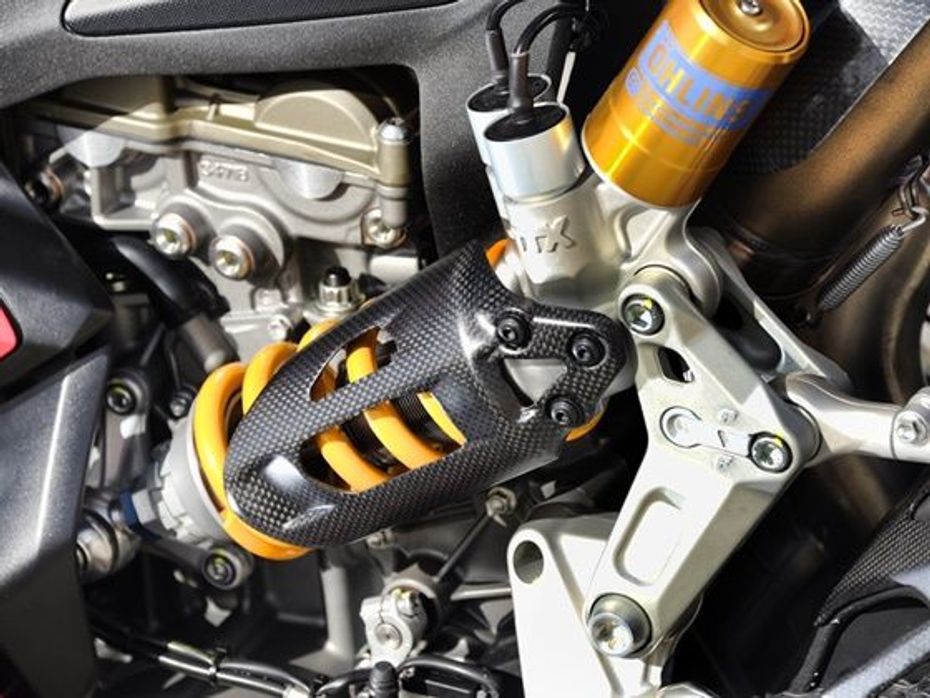
With such high level of focus on speed and on-track performance, the suspension on the 1199 Panigale could not be left far behind with regards to its quality and performance. On the front-end of the standard 1199 Panigale are lightweight Marzocchi-made 50mm upside down forks with an advanced pressurized oil system for lesser use of oil in the suspension. But the rear suspension has a few tricks up its sleeve. New chassis with longer swingarm meant the rear suspension could also be altered and designed for better damping performance allowing for additional settings to suit the rider’s needs. Welcome the horizontally placed side-mounted fully adjustable unit by Sachs on the standard 1199 Panigale that can be adjusted via a pushrod mechanism that connects the swingarm to the suspension unit via an arrow-headed linkage. Another of the many firsts found on the 1199 Panigale, the rider can change the way the rear suspension behaves (progressive or flat) by adjusting where the pushrod connects to the linkage. The more the distance the swingarm travels, the higher will be the resistance from the rear shock absorber – progressive while in the flat settings the rear suspension remains unaffected by the position of the swingarm.
Sounds like too much of a hassle? Then you probably would be interested in knowing about the high-spec 1199 Panigale S and the 1199 Panigale S Tricolore versions, both of which introduce for the first time in the superbike class, electronically adjustable suspension with a 43mm fully-adjustable Ohlins forks on the front and an Ohlins TTX36 fully adjustable monoshock at the rear. The brakes too are exotic with Ducati signing a pact with Italian brake manufacturer Brembo to exclusively supply the Brembo M50 high-performance monobloc 4-piston calipers for the 1199 Panigale, which means no other bike will get these brakes as standard equipment. Machined out of a single piece of alloy, the Brembo stopping units on the standard 1199 Panigale are not only the latest in braking technology, they have further helped Ducati reduce the weight on the 1199 Panigale by about 500grams identical to the weight saved by each of the two exotic 10-spoke Marchesini wheels on the standard model.
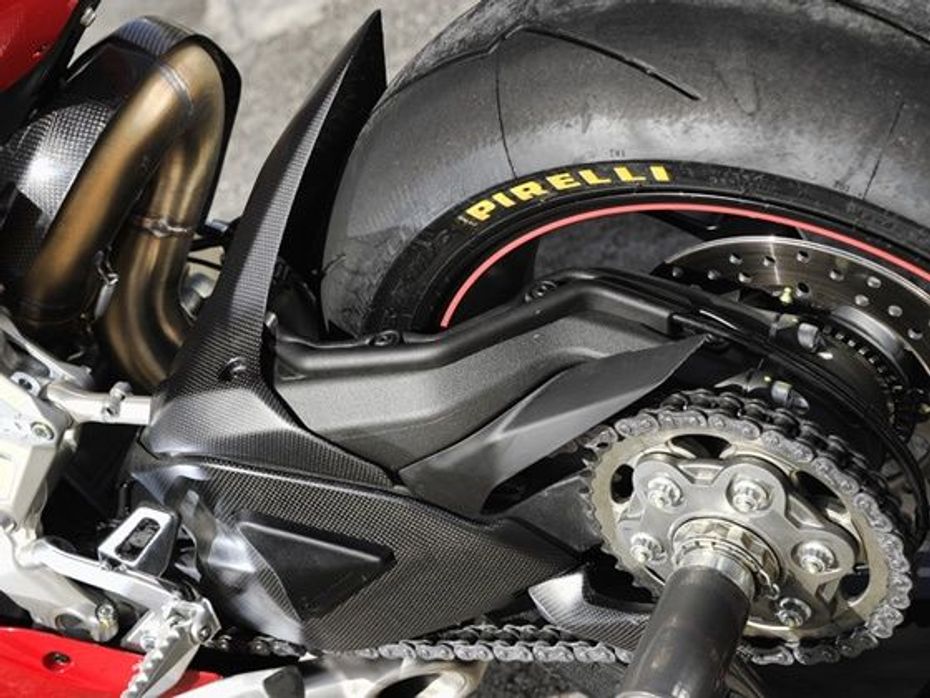
The deep-pocketed bikers get the world’s most advanced hydraulically linked ABS technology developed by Bosch on the top-end variants – the 1199 Panigale S (optional) and the 1199 Panigale S Tricolore (standard fitment). Employing special lean angle and wheel-speed sensors, the high-tech braking system can apply the most accurate ratio for the front-to-rear braking force. For the not-so-weak-at-heart riders, they can anytime switch off the ABS manually via dashboard controls. Ofcourse the ABS unit adds to the overall weight to some extent, but then the top-end models get triple 3-spoke forged aluminium wheels that save about 900grams each!
Quite on the right path with the goals set, the other place to save weight was the powerplant which also had to fulfill yet another important criterion of producing 195 horses without compromising on reliability. There was no way Ducati could have achieved the set goals with their existing and dare I say, over-used V-twin motor serving the 1198 and developing an all-new engine was the need of the hour for Bologna-based factory. But crucial parameters like trademark 90-degree V-twin and Ducati-patented Desmodromic valve system could not have been discounted for it to still be called a Ducati and hence those were retained on the SuperQuadro as well. In order to achieve the set target of 195bhp, the engineers opted for a massively short-stroke or SuperQuadro (over-square) bore into stroke configuration of 112mm x 60.8mm – the most radical ever found on any production motorcycle.
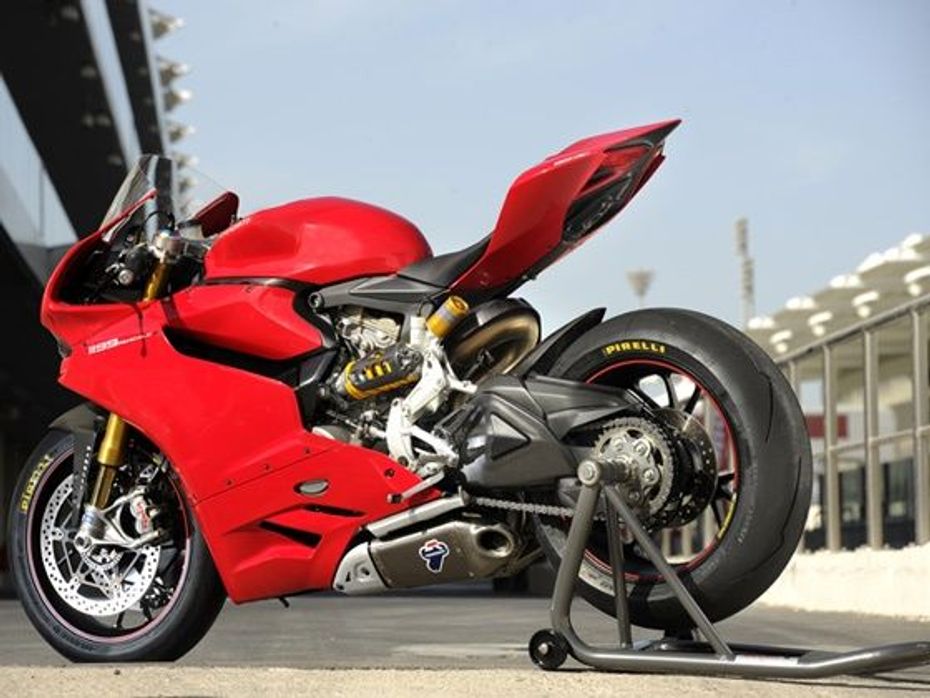
A short stroke arrangement translates into higher rpm resulting into more horsepower but reducing stroke also means a much larger bore in order to maintain the same cubic capacity. Larger bore also allows for the use of larger valves which means better and smoother flow of gases in and out of the combustion chamber, thus further increasing the power from the engine. With years of experience in racing and developing some of the finest V-twin engines the world has ever seen, all these innovations put together helped Ducati squeeze those 20-odd extra horses from the new V-twin engine than what any other Ducati production V-twin makes. The massive bore size meant use of bigger inlet and exhaust valves made out of titanium to lessen the initial inertia, which is where Ducati’s patented Desmodromic valve operation technology came to the rescue of the engineers. The level of precision and efficiency required for smooth functioning of the big valves at extremely high operating speeds could not be achieved with the help of conventional valve closing springs. But the simple-yet-efficient Desmodromic valve mechanism by Ducati with its mechanical functioning could very well deal with the large valves even at extremely high operating speeds, with high precision.
Apart from the extreme bore and stroke ratio, the other significant change in the SuperQuadro motor powering the 1199 Panigale is the replacement of trademark Ducati cam belt drive for a more advanced combination of chain and gear driven cam mechanism. Tensioned automatically in order to reduce service and maintenance costs, the chain and gear drive system has allowed for efficient and smooth functioning of the cams drastically improving engine performance and reliability. While the power and reliability was taken care by smart technologies and use of exotic materials within the engine components, for reducing the overall weight of the engine an equally radical approach to integrate many of the components like cooling water channels and oilways inside the engine itself was adopted – ‘compact engineering’ as Ducati calls it.
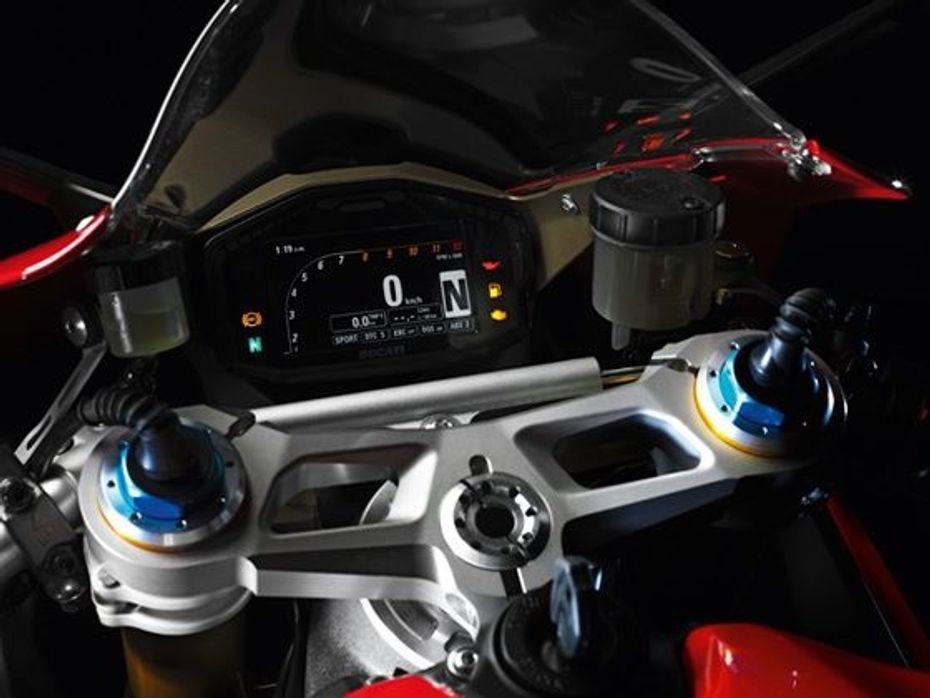
Whatever the company might call it, an interesting way to describe this gorgeous new contraption from Bologna is the way Ducati’s test rider Alessandro Valia, who tested the machine at Mugello circuit and the Nardo test-track in Italy for over a span of eighteen months, calls it, “Astronomical”. What else can one call a motorcycle that pumps out 195 horses and weigh just 164kg dry? It is nothing short of a crotch-rocket boasting class-leading power-to-weight and torque-to-weight ratios of 1189.02PS/tonne and 811Nm/tone, respectively. Bathed in technologies, some of which have been developed for aerospace industry for instance the use of polymeric-like carbon (PLC) on the Desmodromic rocker arms for reduced friction and increased strength just goes on to say how imperative and crucial the 1199 Panigale is to its maker. With the development on the 1198’s V-twin technology reaching its peak, Ducati had little choice than to build an all-new engine from ground up as a worthy successor to the 1198 as well as a new platform for future models. And for which, there were no compromises made. The money rolled in, the right people with the right information and skill set were roped in for the 1199 Panigale project. As Domenicalli clearly states, “This sort of bike is Ducati’s focus and it is very important for us. We are a sports bike manufacturer so we wanted to offer a product that gets better and better. There was no other way of making a massive step without investing in a fresh new engine.”
To put things in perspective, two years ago the BMW S1000RR did a fairly decent job of raising the bar and stealing the crown from the Japanese majors in the race for performance numbers. But the Ducati 1199 Panigale does a lot more than just post fastest laptimes. It brings to the fore a new breed of racing motorcycles for the street that shall play a big role in determining the direction the future of superbikes might take – LED headlights for a cleaner and sharper look, an advanced braking system for improved safety, Ducati Data Analyzer+ System with built-in GPS that links to the on-board laptimer in Race Mode, electronically adjustable suspension, Engine Brake Control borrowed from Ducati’s MotoGP learnings, TFT fully-digital advanced dashboard and so on, the list can go very long, quite like the Ducati 1199 Panigale’s service interval schedules stretched for a whooping 24,000km! There is no way any motorcyclist in his right mind would disagree that this has been the most significant development from Ducati since a long time and that the 1199 Panigale is the latest benchmark, the new yardstick which has raised the bar well beyond just the realms of speed and performance. A masterstroke by Ducati, the 1199 Panigale borders on perfection of a road-bike but clearly surpasses the boundaries of thrill and innovation. Enough said.
 Honda Hness CB350
Honda Hness CB350
 Yamaha FZ-X
Yamaha FZ-X
 Bajaj Avenger Street 160
Bajaj Avenger Street 160
 Keeway SR125
Keeway SR125
 Kawasaki W175
Kawasaki W175
India's largest automotive community
 Ducati Panigale V4
Rs. 27.72 Lakh
Ducati Panigale V4
Rs. 27.72 Lakh
 Ducati Streetfighter V4
Rs. 24.62 Lakh
Ducati Streetfighter V4
Rs. 24.62 Lakh
 Ducati Monster
Rs. 12.95 Lakh
Ducati Monster
Rs. 12.95 Lakh
 Ducati Scrambler 800
Rs. 10.39 Lakh
Ducati Scrambler 800
Rs. 10.39 Lakh
 Ducati Diavel V4
Rs. 25.91 Lakh
Ducati Diavel V4
Rs. 25.91 Lakh